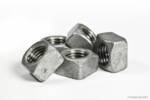Dane's FAQs
All bolts we manufacture are made to imperial measurements. The primary reason for this is because the steel used to make bolts is milled to imperial sizes. Even though metric measurements are almost exclusively used internationally, most raw materials are only available domestically in inches. Often projects, such as highways, bridges, and power plants specify... Read more
It seems like this question is directed toward clevis pins that are used to connect control assemblies, linkages and perhaps hinges. In these applications where rotation of the clevis pin is anticipated, I agree that a washer would protect the retaining device from possible ‘side effects’ of the rotation. In the case of pins that... Read more
ASTM A325 and SAE J429 grade 8 are not the same fastener. As a matter of fact, they couldn’t be more different. SAE (Society of Automotive Engineers) establishes specifications covering fasteners intended for use in automotive, OEM, and equipment applications, while ASTM (American Society for Testing and Materials) provides specifications for construction fasteners. There are... Read more
Most ASTM standards address the recommended application of the fastener. There are often two or three different ASTM specifications with similar chemical and mechanical properties, but with differing applications. ASTM F1554 is a specification that is designed for anchor bolts embedded in concrete. Since your application is for tie rod assemblies, it would appear that... Read more
ASTM A36 is a steel (raw material) specification, while ASTM A307 is a fastener specification. In other words, once you take A36 round bar and cut it, thread it, bend it, forge a head on it, or otherwise process it and turn it into a fastener, it becomes an A307 bolt. Often times, ASTM A307... Read more
RA% is a term that stands for “reduction of area percentage.” It is an important requirement of the ASTM F1554 specification, in addition to other specifications. This value is reported as a percentage of the original test piece. When fasteners undergo mechanical testing, they are pulled to failure and the diameter of the point at which... Read more
The lines on the head of a bolt indicate its grade. SAE J429 (Society of Automotive Engineers) bolts have radial lines, whereas ASTM (American Society for Testing and Materials) uses a combination of letters and numbers to indicate the grade. Three radial lines will indicate an SAE grade 5 fastener, while six radial lines will... Read more
No. As a matter of fact, nobody does. The ASTM F3125 grade A325 specification clearly denotes the diameter range of this grade of fastener to be ½” through 1-1/2” inclusive. Therefore, an A325 bolt larger than 1-1/2” diameter simply does not exist. It cannot be manufactured because there are no dimensional or strength requirements for... Read more
We’ll try our best. The relationship between tension and torque should be looked at cautiously, since it is very difficult to indicate the range of conditions expected to be experienced by a fastener. Torque is simply a measure of the twisting force required to spin the nut up along the threads of a bolt, whereas... Read more

No. Hot-dip galvanized nuts need to be used with hot-dip galvanized bolts since galvanized nuts are tapped oversize to accommodate for the extra 2 – 6 mils (.002 – .006) of zinc that is added to the threads of the bolt during the galvanizing process. A common misconception is that bolts that are going to... Read more


